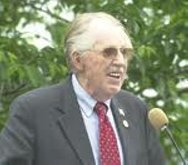
REP. BAIRD: I thank you, Ms. Woolsey. I wouldn’t expect the panelists to be aware of this, but the gentleman now about to ask questions is probably the leading authority in the Congress on some of this because he is virtually off the grid, if not entirely off the grid, and has been doing renewable energy in his home, walking the talk for many, many years. So with that, I’m pleased to recognize Dr. Bartlett.
REP. ROSCOE G. BARTLETT (R-MD): Thank you very much. You know, in thinking about these alternative energies, we need to think about them in a different context. The context in which we ordinarily consider them is the present context where about half of our electricity comes from coal. And if you’re comparing these renewables with fossil fuels, they aren’t going to look very good, because the quantity and quality of energy in fossil fuels is just unsurpassed.
(continues)
Where else can you find that quantity and quality of energy? The general statement is that we have 250 years of coal at current use rates. Be careful with that — current use rates, because just 2 percent increase doubles in 35 years, four times bigger in 70 years, eight times bigger in 105 years, 16 times bigger in 140 years.
I hope we’ll still be here as a country 140 years from now.
The National Academy of Science says that we probably have 100 years of coal at current use rates, but even if we have the 250 years and you increase its use only 2 percent — and we will increase its use more than that as we have to turn to coal for gas and liquids. But even if you increase it only 2 percent, the 250 years now drops to 85 years. That’s the power of compound interest, which Albert Einstein says was the most powerful force in the universe.
And now if you take some of the energy from that coal to produce a gas or a liquid, now it shrinks to 50 years. And there is an inevitability that few people understand, and that is that you will share it with the world of necessity, because if we’re getting oil from coal, then the Saudi oil goes to somebody else. So in reality, you have no choice but to share it with the world. What that means is that the — 50 years now shrinks to 12 and a half years. So if you make two assumptions — one is that the use of coal will increase just 2 percent, and the other is the inevitability that you will share it with the world. We have 12 and a half years of coal left.
So the context in which we need to be thinking about these alternative energies is a world in which we do not have the abundance of fossil fuels that we have today. Then they start to look a whole lot different, don’t they? But we have huge problems with the intermittent production of energy by wind and by sun. And so we need hugely increased focus today on storage, do we not? Because you can get all the energy that you need from solar. You can get all the energy you need from wind, but boy, is it sporadic. And we have grossly inadequate ways of storing it today. Where are we in this balance between looking at the renewables and looking at ways of storing the — because don’t you think that the utility of these renewables in the future will be largely depent on our ability to quickly store and release the energy we get from them?
MR. ROSENBLUM: Congressman Barton, Bartlett, can I first address that? I think one of the first things before we engage wholly in the idea of storage, which I do think is important, is we look — need to look at other market structure improvements, such as larger geographic areas in which we transact energy, because I think that may be a more direct way to increase the flexibility of resources that we utilize to balance the variability that we’re talking about. REP.
BARTLETT: But you really can’t — (inaudible) — this stuff too far, can you? Unlike oil, you put a gallon in here, and a thousand miles away a gallon comes out. You put electrons in a wire at this , and a thousand miles away nothing may come out as a result of line loss.
Aren’t there some limitations to equalizing, to normalizing, the production if you just include the whole country?
MR. ROSENBLUM: Well, I would say that’s something we need to study, but one of the things that we have observed is that the broader the geographic area that you can use to balance, there probably are benefits, and we need to look at transmission associated with that.
You’re correct.
MR. MOONEY: Congressman Bartlett, I think you raise a very important point, and just as wind or any single technology is not the solution there, in addition to forecasting, there are many things that we can do to address the variability of wind and solar generating plants. Storage, I think, is certainly one and will likely be apart of the solution. There are, as was discussed here earlier — there are market structures that could be changed that — to make integration easier. There are operational techniques that can be implemented. For example, looking at wider geographic areas for integrating renewables, so — and that is on top of potential efficiency and demand response — and demand response technologies and techniques. So there’s a whole portfolio if we look at this as an entire system that will help to address that variability.
REP. BARTLETT: Thank you, and I yield back.
REP. BAIRD: Thank you, Dr. Bartlett.